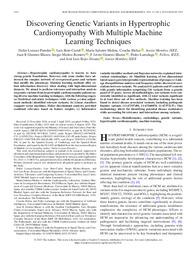Please use this identifier to cite or link to this item:
https://hdl.handle.net/11000/37192Full metadata record
| DC Field | Value | Language |
|---|---|---|
| dc.contributor.author | Lozano-Paredes, Dafne | - |
| dc.contributor.author | Bote-Curiel, Luis | - |
| dc.contributor.author | Sabater-Molina, Maria | - |
| dc.contributor.author | Bielza, Concha | - |
| dc.contributor.author | Gimeno Blanes, Juan Ramón | - |
| dc.contributor.author | Muñoz-Romero, Sergio | - |
| dc.contributor.author | Gimeno Blanes, Francisco Javier | - |
| dc.contributor.author | Larrañaga, Pedro | - |
| dc.contributor.author | Rojo-Álvarez, José Luis | - |
| dc.contributor.other | Departamentos de la UMH::Ingeniería de Comunicaciones | es_ES |
| dc.date.accessioned | 2025-09-03T09:52:32Z | - |
| dc.date.available | 2025-09-03T09:52:32Z | - |
| dc.date.created | 2025 | - |
| dc.identifier.citation | IEEE Transactions on Computational Biology and Bioinformatics | es_ES |
| dc.identifier.issn | 1557-9964 | - |
| dc.identifier.issn | 1545-5963 | - |
| dc.identifier.uri | https://hdl.handle.net/11000/37192 | - |
| dc.description.abstract | Hypertrophic cardiomyopathy is known to have strong genetic foundations. However, only some studies have addressed the complex network of co-expressed genes and variants that modify the phenotype. Machine learning methods offer robust information discovery when dealing with high-dimensional datasets. We aimed to perform relevance and interaction analysis on genetic variants from hypertrophic cardiomyopathy patients using diverse machine learning techniques, with the following stages: (a) Statistical univariate techniques (with various p-value adjustment methods) identified relevant variants; (b) Linear classifiers (support vector machines, Fisher discriminant analysis) provided combined relevance based on feature weights; (c) Informative variable identifier method and Bayesian networks explained inter-variant relationships; (d) Manifold learning of low-dimensional latent spaces gave interpretable representations of groups; (e) Linkage disequilibrium matrices and frequency tables discovered associations between variants. We analyzed 61 patients and 67 controls with genetic information comprising 216 variants from a genetic panel of 15 genes. Across all methodologies, ten variants were consistently identified as significant, with 22 total variants significant in at least three out of five methods. Machine learning has been found to detect disease-associated variants, including pathogenic founder variants (11:47357494, 11:47360070, 11:47372137). This methodology allows for identifying potential disease modulators while accounting for relevance and interactions among variants. | es_ES |
| dc.format | application/pdf | es_ES |
| dc.format.extent | 14 | es_ES |
| dc.language.iso | eng | es_ES |
| dc.publisher | IEEE | es_ES |
| dc.relation.ispartofseries | 22 | es_ES |
| dc.relation.ispartofseries | 4 | es_ES |
| dc.rights | info:eu-repo/semantics/openAccess | es_ES |
| dc.rights | Attribution-NonCommercial-NoDerivatives 4.0 Internacional | * |
| dc.rights.uri | http://creativecommons.org/licenses/by-nc-nd/4.0/ | * |
| dc.subject | Bioinformatics | es_ES |
| dc.subject | Embeddings | es_ES |
| dc.subject | Genetic variants | es_ES |
| dc.subject | Hypertrophic cardiomyopathy | es_ES |
| dc.subject | Machine learning | es_ES |
| dc.subject.other | CDU::6 - Ciencias aplicadas::62 - Ingeniería. Tecnología | es_ES |
| dc.title | Discovering Genetic Variants in Hypertrophic Cardiomyopathy With Multiple Machine Learning Techniques | es_ES |
| dc.type | info:eu-repo/semantics/article | es_ES |
| dc.relation.publisherversion | https://doi.org/10.1109/TCBBIO.2025.3572833 | es_ES |

View/Open:
Discovering_Genetic_Variants_in_Hypertrophic_Cardiomyopathy_With_Multiple_Machine_Learning_Techniques.pdf
4,23 MB
Adobe PDF
Share:
.png)
